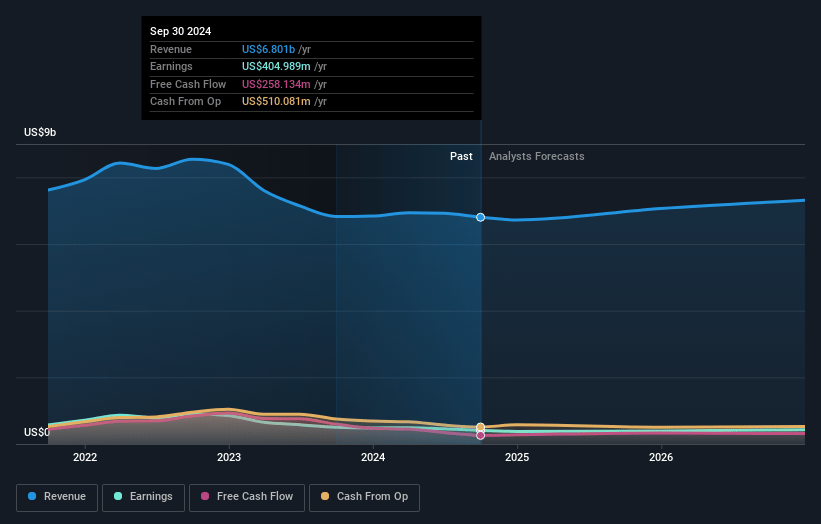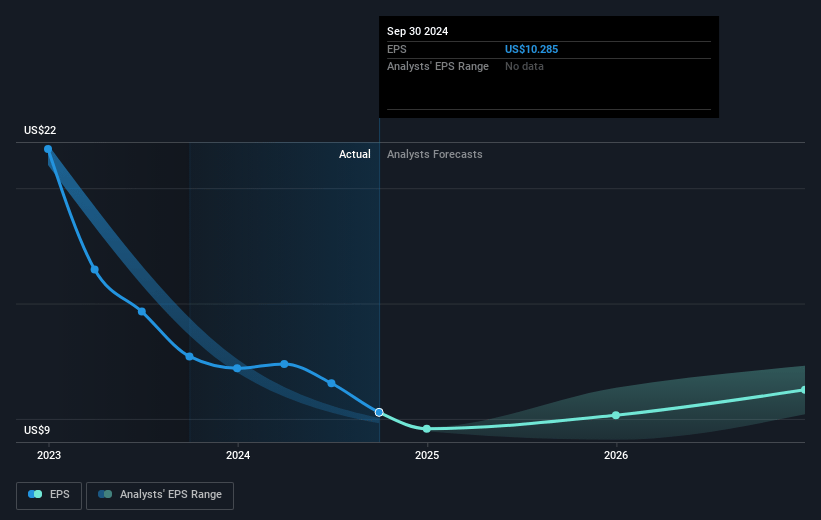Narratives are currently in beta
Key Takeaways
- Strategic capital investments and expansion initiatives aim to enhance production and diversify offerings, potentially driving future revenue and margin improvement.
- Strengthening distribution and share repurchase plans indicate a focus on efficiency and shareholder value, possibly boosting gross margins and earnings per share.
- Decline in housing starts and increased competition may negatively impact Boise Cascade's revenue, profitability, and future growth due to suppressed demand and lower sales prices.
Catalysts
About Boise Cascade- Engages in manufacture of wood products and distribution of building materials in the United States and Canada.
- Boise Cascade plans to increase capital spending to $200 million to $220 million in 2025, targeting growth projects, which could drive future revenue growth as these investments enhance production capabilities.
- The company anticipates modest growth in home improvement spending in 2025, which should favorably impact revenue through increased demand for its building materials, supported by the aging U.S. housing stock and elevated homeowner equity.
- Boise Cascade's emphasis on strengthening its distribution network, specifically in general line product sales, is expected to improve gross margins by increasing efficiency and optimizing product mix to higher-margin offerings.
- The expansion of the BROSCO business and strategies like expanding door and millwork offerings indicate potential for revenue growth and diversification, which may positively impact net margins by leveraging existing distribution channels.
- The company's robust share repurchase program, coupled with dividend payments, demonstrates management's commitment to enhancing shareholder value and might foreseeably bolster earnings per share by reducing the number of shares outstanding.
Boise Cascade Future Earnings and Revenue Growth
Assumptions
How have these above catalysts been quantified?- Analysts are assuming Boise Cascade's revenue will grow by 3.4% annually over the next 3 years.
- Analysts assume that profit margins will shrink from 6.0% today to 5.7% in 3 years time.
- Analysts expect earnings to reach $430.0 million (and earnings per share of $11.5) by about November 2027, up from $405.0 million today. The analysts are largely in agreement about this estimate.
- In order for the above numbers to justify the analysts price target, the company would need to trade at a PE ratio of 15.4x on those 2027 earnings, up from 13.1x today. This future PE is lower than the current PE for the US Trade Distributors industry at 17.0x.
- Analysts expect the number of shares outstanding to decline by 0.9% per year for the next 3 years.
- To value all of this in today's terms, we will use a discount rate of 7.07%, as per the Simply Wall St company report.
Boise Cascade Future Earnings Per Share Growth
Risks
What could happen that would invalidate this narrative?- Decline in U.S. housing starts and single-family housing starts could negatively impact revenue and earnings due to decreased demand for Boise Cascade's wood products.
- Lower sales prices for EWP and plywood combined with higher conversion costs have reduced segment EBITDA, posing a risk to net margins and overall profitability.
- Increased competition from alternative building materials, such as concrete for flooring, may further reduce sales volumes of products like I-joists, impacting revenues.
- Seasonal sales and pricing erosion in Q4, along with two fewer sales days, could result in reduced earnings compared to previous quarters, affecting near-term financial performance.
- Economic uncertainties and higher mortgage rates, which continue to limit housing affordability, may suppress demand for housing-related products, thus impacting Boise Cascade’s future revenue growth.
Valuation
How have all the factors above been brought together to estimate a fair value?- The analysts have a consensus price target of $146.17 for Boise Cascade based on their expectations of its future earnings growth, profit margins and other risk factors. However, there is a degree of disagreement amongst analysts, with the most bullish reporting a price target of $161.0, and the most bearish reporting a price target of just $125.0.
- In order for you to agree with the analyst's consensus, you'd need to believe that by 2027, revenues will be $7.5 billion, earnings will come to $430.0 million, and it would be trading on a PE ratio of 15.4x, assuming you use a discount rate of 7.1%.
- Given the current share price of $138.18, the analyst's price target of $146.17 is 5.5% higher. The relatively low difference between the current share price and the analyst consensus price target indicates that they believe on average, the company is fairly priced.
- We always encourage you to reach your own conclusions though. So sense check these analyst numbers against your own assumptions and expectations based on your understanding of the business and what you believe is probable.
How well do narratives help inform your perspective?
Disclaimer
Warren A.I. is a tool utilizing a Large Language Model (LLM) that ingests data on consensus price targets, forecasted revenue and earnings figures, as well as the transcripts of earnings calls to produce qualitative analysis. The narratives produced by Warren A.I. are general in nature and are based solely on analyst data and publicly-available material published by the respective companies. These scenarios are not indicative of the company's future performance and are exploratory in nature. Simply Wall St has no position in the company(s) mentioned. The price targets and estimates used are consensus data, and do not constitute a recommendation to buy or sell any stock, and they do not take account of your objectives, or your financial situation. Note that Warren A.I.'s analysis may not factor in the latest price-sensitive company announcements or qualitative material.
Read more narratives
There are no other narratives for this company.
View all narratives



